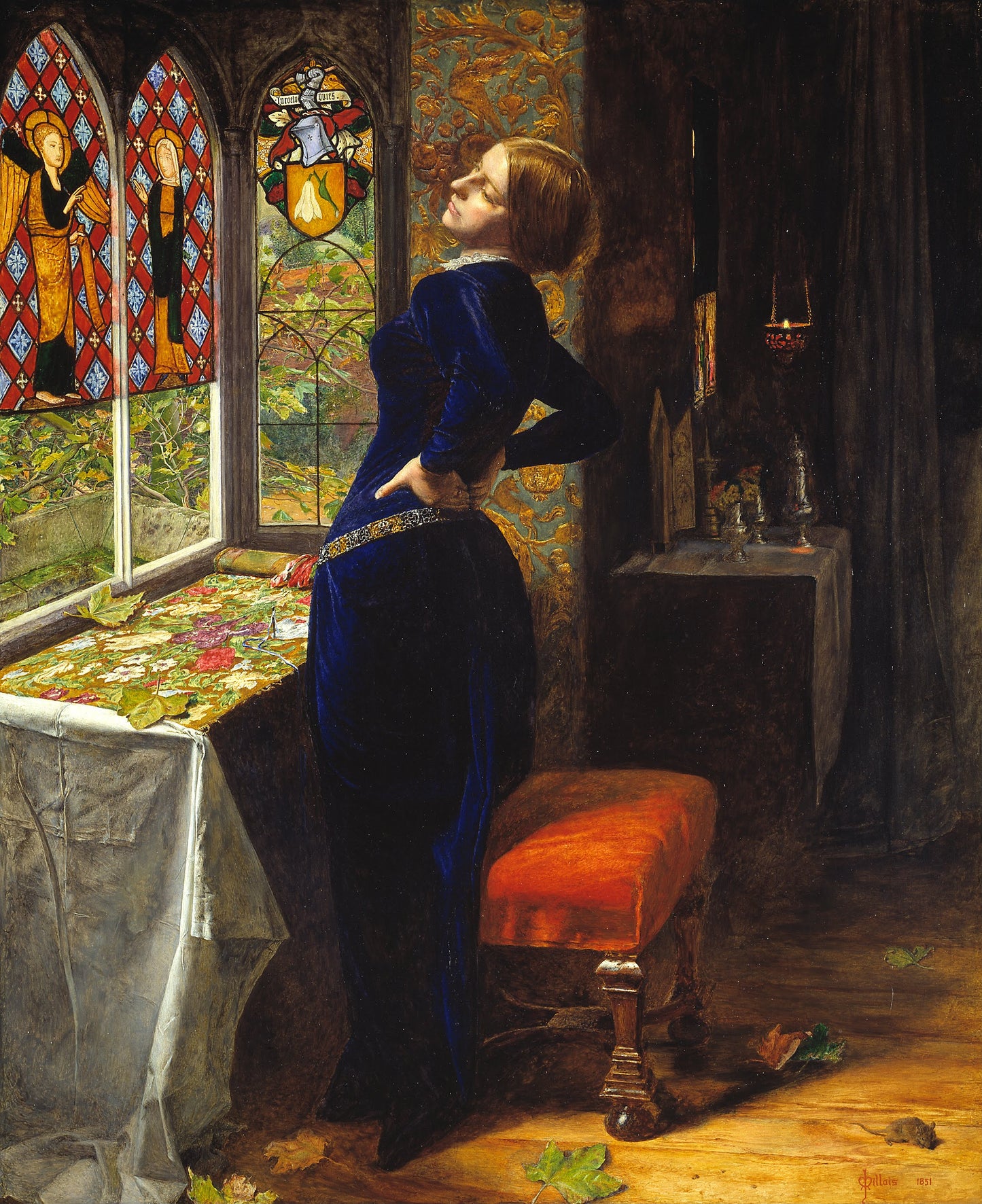Romantic English
"Mariana," Sir John Everett Millais Oil-on-Canvas Reproduction
"Mariana," Sir John Everett Millais Oil-on-Canvas Reproduction
Couldn't load pickup availability
This evocative painting is "Mariana," created in 1851 by the Pre-Raphaelite artist Sir John Everett Millais, inspired by a character from Shakespeare’s Measure for Measure and Tennyson’s poem Mariana. The scene depicts Mariana, a woman abandoned by her lover, in a moment of deep reflection and perhaps quiet despair. Millais masterfully captures her emotional state through a combination of intricate symbolism and meticulous detail.
The composition centers on Mariana herself, standing before an arched window with a distant gaze. Her figure, dressed in a deep, rich blue velvet gown, stands in stark contrast to the golden and autumnal tones surrounding her. The gown, fitting her figure with its opulence and weight, represents her isolation and stagnation, as if she is trapped in time, waiting for her lost love. Her posture, with her back slightly arched and hands resting on her lower back, suggests weariness, possibly both physical and emotional, as she yearns for something that may never come.
Behind her, the light streaming through the stained-glass windows offers a sharp contrast to the darker, confined space in which she stands. The stained glass itself features figures from religious imagery, with angelic figures dressed in ornate robes. The brilliance of the light filtering through the glass provides a reminder of the world outside—vivid, colorful, and alive—yet Mariana remains enclosed, trapped in her sorrow. Her surroundings, while ornate and filled with symbols of beauty, become a prison, reflecting her melancholy state.
The window opens out into a lush garden, with foliage and greenery just visible through the panes. This view of nature, full of life, contrasts with the dried autumn leaves scattered on the ground and table within the room, symbolic of Mariana’s own sense of decay and emotional dormancy. The leaves on the windowsill and floor indicate the passing of time, a poignant reminder of her long, unfulfilled wait.
Millais, a master of texture and detail, has filled the room with meaningful elements. The elaborate embroidery on the table, rich with vivid reds and greens, might suggest the intricate life that could have been, but now lies unused. The tapestry that adorns the wall, along with the small altar behind Mariana, hints at the spiritual and possibly divine nature of her suffering, but it also reinforces the idea of being bound by duty and virtue, with no escape in sight.
The light coming in from the window illuminates her pale skin and the vibrant blue of her dress, creating a subtle interplay between shadow and light, which furthers the mood of longing. Mariana’s head, turned slightly to the side with eyes half-closed, seems to be lost in thought. Her expression, delicate and serene, suggests resignation to her fate. It’s a moment of quiet contemplation, but also one of enduring pain.
The floor beneath her feet, scattered with more autumn leaves, adds a sense of transience to the scene. These fallen leaves, in contrast to the fresh and vibrant greens outside the window, symbolize the inexorable passage of time and perhaps the slow decline of her hopes.
Mariana is a masterpiece of emotional subtlety, with Millais capturing not only the quiet suffering of its subject but also the beauty of detail and the profound symbolism that makes every object in the scene resonate with meaning. It’s a portrait of longing, time, and solitude—a visual poem that mirrors the tone of Tennyson’s words: "She only said, 'My life is dreary, / He cometh not,' she said."


